ASM Metals HandBook Vol. 17 - Nondestructive Evaluation and Quality Control
Подождите немного. Документ загружается.

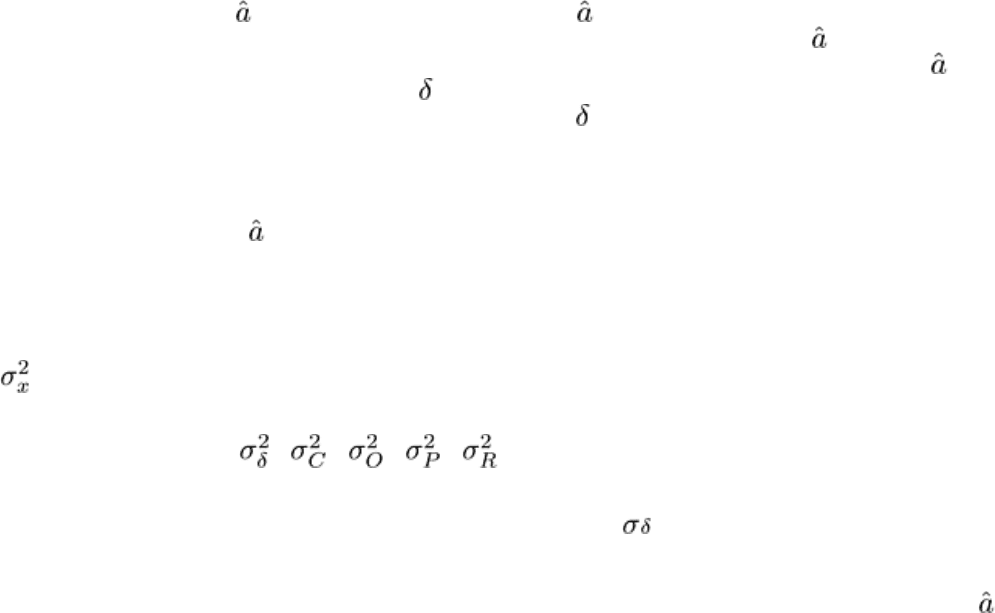
The generality of the capability characterization is limited to the application for which the experiment is representative.
Either important factors must be typical of the application or random samples must be chosen from the population of
interest and repeat inspections performed for these factors. For example, if a single inspector is used to characterize a
fluorescent penetrant inspection, it must be assumed that this inspector is typical of all the inspectors in the shop. An
alternative might be to choose a random sample of inspectors from the total pool and have each of the selected inspectors
perform the experiment.
Depending on the application of the results of the experiment, stratified sampling may be required to obtain a
representative sample. For instance, if the capability will apply to two facilities and one of them inspects twice as many
components as the other, then that facility should have twice as many inspectors in the experiment. An alternative method
is to characterize each facility independently. Care is then required in combining the results for the joint characterization.
Factorial Experiments for Hit/Miss Data. The analysis for the hit/miss data requires that all factors be balanced in
any one analysis. When practical, this can be most easily achieved by performing complete factorial experiments. For
example, Table 1 contains the results of a two-factor experiment, with the factors being cracks and inspectors. These data
can be analyzed as one data set with three inspections per crack. The resulting POD(a) function and its confidence bound
would be representative of the population of inspectors from which the sample was drawn.
If the effect of a third factor, for example, different lots of penetrants, were to be included, the entire experiment would be
repeated for each of the lots chosen at random from the population of all lots. If three lots were sampled, a total of nine
inspections would be performed on each of the flawed specimens, and the resulting POD(a) would apply to the entire
inspection process. Suppose, however, that the second and third samples of penetrant were used only by Inspector A. In
this case, the two additional sets of inspection data cannot be combined with the other three in a single analysis, because
the triple representation of Inspector A would bias the resulting POD(a) function toward his specific capability. The three
sets of inspection results for Inspector A can be combined, but the range of applicability of the answer is limited to
Inspector A (unless it can be shown or assumed that Inspector A is representative of the entire population).
When many factors must be considered, the number of possible combinations in a factorial experiment can easily become
prohibitive. More sophisticated experimental designs (fractional replications, for example) may then be required. In such
cases, the assistance of a professional statistician is recommended.
Experimental Design for Data. Inspection-result data in the form contain considerably more information than
hit/miss data and, as a consequence, permit more flexibility in the design of the experiment. In analysis, the parameters
of the POD(a) function are estimated from the slope, intercept, and standard deviation of residuals of the ln ( ) versus ln
(a) relation, as given by Eq 9, 12, and 13. In Eq 9, can be considered to be the sum of random effects, and experiments
can be designed to estimate the components of the total variation in . For example, operators, probes, and repeatability
can be jointly evaluated in a factorial experiment and their effects accounted for in the estimate of POD(a). The statistical
model for this experiment would be:
ln ( ) = β
0
+ β
1
ln (a) + C
i
+ O
j
+ P
k
+ R
l
+ (interaction terms)
(Eq 14)
where C
i
, O
j
, P
k
, and R
l
are the random effects due to cracks, operators, probes, and repeats, respectively. The random
term, δ of Eq 9, is the sum of all random effects. It can be assumed that the mean and variance of random effect X are zero
and , respectively. Then:
= + + + + . . .
(Eq 15)
Therefore, β
0
and β
1
can be estimated from a regression analysis, and can be estimated from the components of
variance using the expected mean squares for the random effects.
In principle, any statistical design from which the components of variance can be estimated can be used in an NDE
reliability experiment. However, the analysis methods would be specific to the particular design, and it is beyond the
scope of this article to address the general problem. In the section "Signal Response Analysis" in this article, it will be

assumed that only the variation due to cracks and one other factor is being investigated. It is recommended that the
assistance of a qualified statistician be obtained for more sophisticated experimental designs.
Sample Sizes and Flaw Sizes
Sample sizes in NDE reliability experiments are driven more by the economics of specimen fabrication and
characterization than by the desired degree of precision in the estimate of the POD(a) function. Although apparently
reasonable POD(a) functions can often be obtained from applying the maximum likelihood analysis to relatively few test
results, the confidence bound calculation is based on asymptotic (large sample) properties of the estimates. It should be
emphasized that the calculations can also produce totally unacceptable results from the relatively few test results or from
data that are not reasonably represented by the assumptions of the models. Therefore, there are minimal sample size
requirements that must be met to provide a degree of reasonable assurance in the characterization of the capability of the
system.
Larger sample sizes in NDE reliability experiments will, in general, provide greater precision in the estimate of the
POD(a) function. However, the sample size is determined from the number of cracks in the experiment, and there is a
coupling with the flaw sizes that must also be considered. The effect of this coupling manifests itself differently for the
hit/miss and analyses.
Sample Size Requirements for Hit/Miss Analysis. Data from hit/miss experiments are generally not amenable to
testing assumptions regarding the form of the POD(a) model. These tests require either large numbers of independent
inspections on each flaw of a specimen set or inspection results from an extremely large number of compatible specimens
(Ref 3, 4). Number and size considerations in hit/miss experiments are directed at their effect on the sampling properties
of the parameters of the POD(a) function (Ref 9).
In the hit/miss analysis, the output of an inspection states only whether or not a crack of known length was found in the
inspection (Table 1). There are probabilities associated with the outcomes, and the analysis assumes that this probability
increases with flaw size. Because it has been assumed that the inspection process is in a state of control, there is a range of
flaw sizes over which the POD(a) function is rising. In this flaw size range of uncertainty, the inspection system has
limited discriminating power in the sense that detecting or failing to detect would not be unusual. Such a range might be
defined by the interval (a
0.10
, a
0.90
), where a
p
denotes the flaw size that has probability of detection equal to p; that is:
POD(a
p
) = p
(Eq 16)
Flaws smaller than a
0.10
would then be expected to be missed, and flaws greater than a
0.90
would be expected to be
detected.
In a hit/miss reliability experiment, flaws outside the range of uncertainty do not provide as much information concerning
the POD(a) function as cracks within this range. Cracks in the almost-certain detection range and almost-certain miss
range provide very little information concerning probability of detection. Therefore, in the hit/miss experiment, not all
flaws convey the same amount of information, and the effective sample size is not necessarily the total number of flaws in
the experiment. Adding a large number of very large flaws does not increase the precision in the estimate of the
parameters of the POD(a) function.
In a reliability experiment, the location of the increasing range of the POD(a) function is not known. Further, the same
sets of specimens are often used in many different experiments. Therefore, it is not possible to fabricate a set of
specimens with optimal flaw sizes for a particular experiment. To minimize the chances of completely missing the crack
size range of maximum information and to accommodate the multiple uses of specimens, flaw sizes should be uniformly
distributed between the minimum and maximum of the sizes of potential interest. A minimum of 60 flaws should be
distributed in this range, but as many as economically possible should be used.
Sample Size Requirements for Analysis. The recorded signal response, , provides significantly more
information for analysis. In particular, the POD(a) model is derived from the correlation of the versus a data, and the
assumptions concerning the POD(a) model can be tested using the signal response data. Further, the pattern of
responses can indicate an acceptable range of extrapolation. Therefore, the range of crack sizes in the experiment is not as
critical in an analysis as in a hit/miss analysis. For example, if the decision threshold in Fig. 5 were set at 250 counts, all
but four of the cracks would have been detected. The larger cracks would have provided little information about the
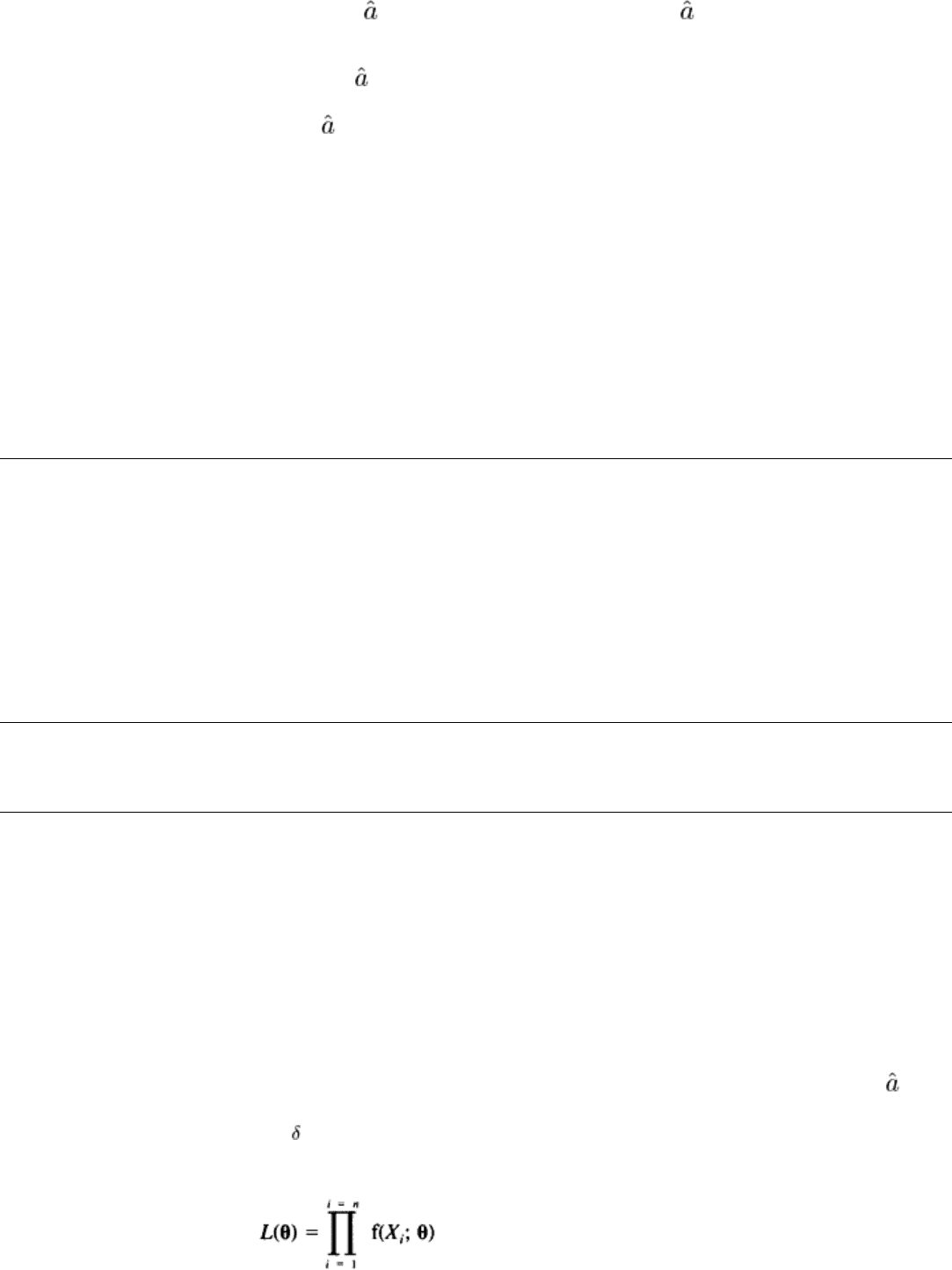
POD(a) function in a hit/miss analysis. In an analysis, however, all of the recorded values provided full information
concerning the relation between signal response and crack size, and the values at the signal threshold and saturation limit
provided partial information. The linearity of the fit, the normality of the deviations, and the constancy of the residual
variation can all be easily evaluated from the versus a plot.
Because of the added information in the data, it is recommended that at least 30 flaws be present in experiments whose
results can be recorded in this form. Increasing the number of flaws increases the precision of the estimates, so the test set
should contain as many flawed specimens as economically feasible.
Unflawed Inspection Sites. In the context of the analyses presented in this section, sample size refers to the number
of known flaws in the specimens to be inspected. The total specimen set should also contain at least twice this number of
unflawed inspection sites. The unflawed sites are necessary to ensure that the NDE procedure is discriminating between
flawed and unflawed sites and to provide an estimate of the false call rate.
Although the false call rate can have important economic consequences, the NDE reliability analyses in this section were
dictated by the requirements of damage tolerance analyses. The primary objective was to estimate the chances of missing
flaws that might lead to structural failures. The concepts of these NDE reliability analyses can be generalized to include a
non-zero probability of a flaw indication when no flaw is present at an inspection site, that is, POD(a = 0) > 0.
References cited in this section
3.
W.H. Lewis, W.H. Sproat, B.D. Dodd, and J.M. Hamilton, "Reliability of Nondestructive Inspections--
Final
Report," SA-ALC/MME 76-6-38-1, San Antonio Air Logistics Center, Kelly Air Force Base, Dec 1978
4.
A.P. Berens and P.W. Hovey, "Evaluation of NDE Reliability Characterization," AFWAL-TR-81-
4160, Vol
1, Air Force Wright-Aeronautical Laboratories, Wright-Patterson Air Force Base, Dec 1981
9.
A.P. Berens and P.W. Hovey, The Sample Size and Flaw Size Effects in NDI Reliability Experiments, in
Review of Progress in Quantitative Nondestructive Evaluation 4B,
D.O. Thompson and D.E. Chimenti, Ed.,
Plenum Press, 1985
NDE Reliability Data Analysis
Alan P. Berens, University of Dayton Research Institute
Maximum Likelihood Analysis
Parameter estimation based on the principle of maximizing the likelihood of an observed sample of data is a standard
statistical technique and is amply described in the literature (Ref 10, 11). The purpose of this section is to summarize the
method and its asymptotic sampling distribution properties in the context of analyzing NDE reliability data. Further, a
method for using this information to calculate lower confidence bounds on the POD(a) function is also presented.
Parameter Estimation. Let X
i
represent the outcome of the ith inspection and f(X
i
;θ) represent the probability of
obtaining X
i
, where θ= (θ
1
, θ
2
,. . .θ
k
)' is the vector of the k parameters in the probability model. For example, in a hit/miss
experiment, X
i
would be 0 or 1 with probability defined by Eq 4, where a is the size of flaw i and θ= (μ,σ)'. In an versus
a experiment, X
i
is the log of the signal response, and f(X
i
;θ) is a normal density function with mean and standard
deviation given by θ= (β
0
+ β
1
ln a, σ )', as defined in Eq 9. Let X
1
,. . ., X
n
represent the results of independent inspections
of n flaws. The likelihood, L, of a specific result is given by the likelihood function:
(Eq 17)
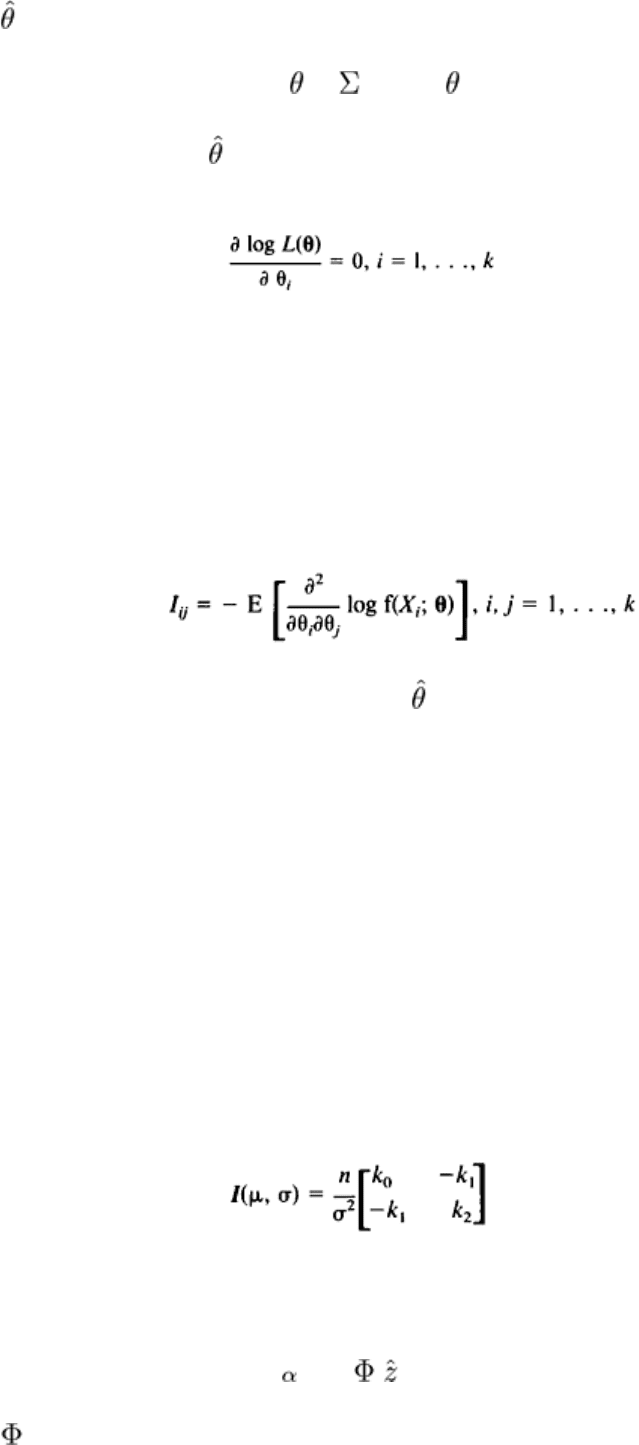
For a given outcome of the experiment, X
i
is known and Eq 17 is a function of θ. The maximum likelihood estimate is the
value, , which maximizes L(θ). For the models considered here, it is more convenient to work with the log L(θ):
log L( ) = log f(X
i
; )
(Eq 18)
which is also maximized at . The maximum likelihood estimates are given by the solution of the k simultaneous
equations:
(Eq 19)
Asymptotic Sampling Distribution Properties. For the models being used in NDE reliability studies, the
maximum likelihood estimates are invariant, consistent, and efficient. Further, they are asymptotically joint normally
distributed with means given by the true parameter values, θ
i
, and the variance-covariance matrix defined by:
V = I
-1
(Eq 20)
where I is the information matrix whose elements I
ij
are the expected (E) values:
(Eq 21)
In application, the maximum likelihood estimate, , is substituted for θ in Eq 21. Therefore, given the results of
inspecting a large number of flaws and a specific function for the POD(a) model, the parameters of the model can be
estimated, and the sampling distribution of the parameters will be joint normal with the known variance-covariance
matrix. Examples of these equations for the hit/miss and response signal models are given in the sections "Analysis of
Hit/Miss Data" and "Signal Response Analysis," respectively, in this article. In these applications, the assumed models
will be the log odds and cumulative log normal distribution functions. However, other models can also be used if
evidence is available to support their selection.
Confidence Bounds on the POD(a) Function. Because the POD(a) function is equivalent to a cumulative
distribution function and the parameters are being estimated by maximum likelihood, a procedure developed by Cheng
and Iles (Ref 12 and 13) can be used to place lower confidence bounds on the POD(a) function. Such bounds are
calculated from the variance-covariance matrix of the estimates and reflect the sensitivity of the experiment to both the
number and sizes of flaws in the specimens of the experiment.
The assumed POD(a) model is a cumulative log normal distribution function with parameters θ= (μ,σ)'. For distribution
functions defined by location and scale parameters (as is the case of the log normal distribution), the information matrix
can be written in the form:
(Eq 22)
where n is the number of cracks in the experiment. The lower one-sided confidence bound of the POD(a) function is
given by:
POD (a) = ( - h)
(Eq 23)
where (z) is the standard cumulative normal distribution, and:
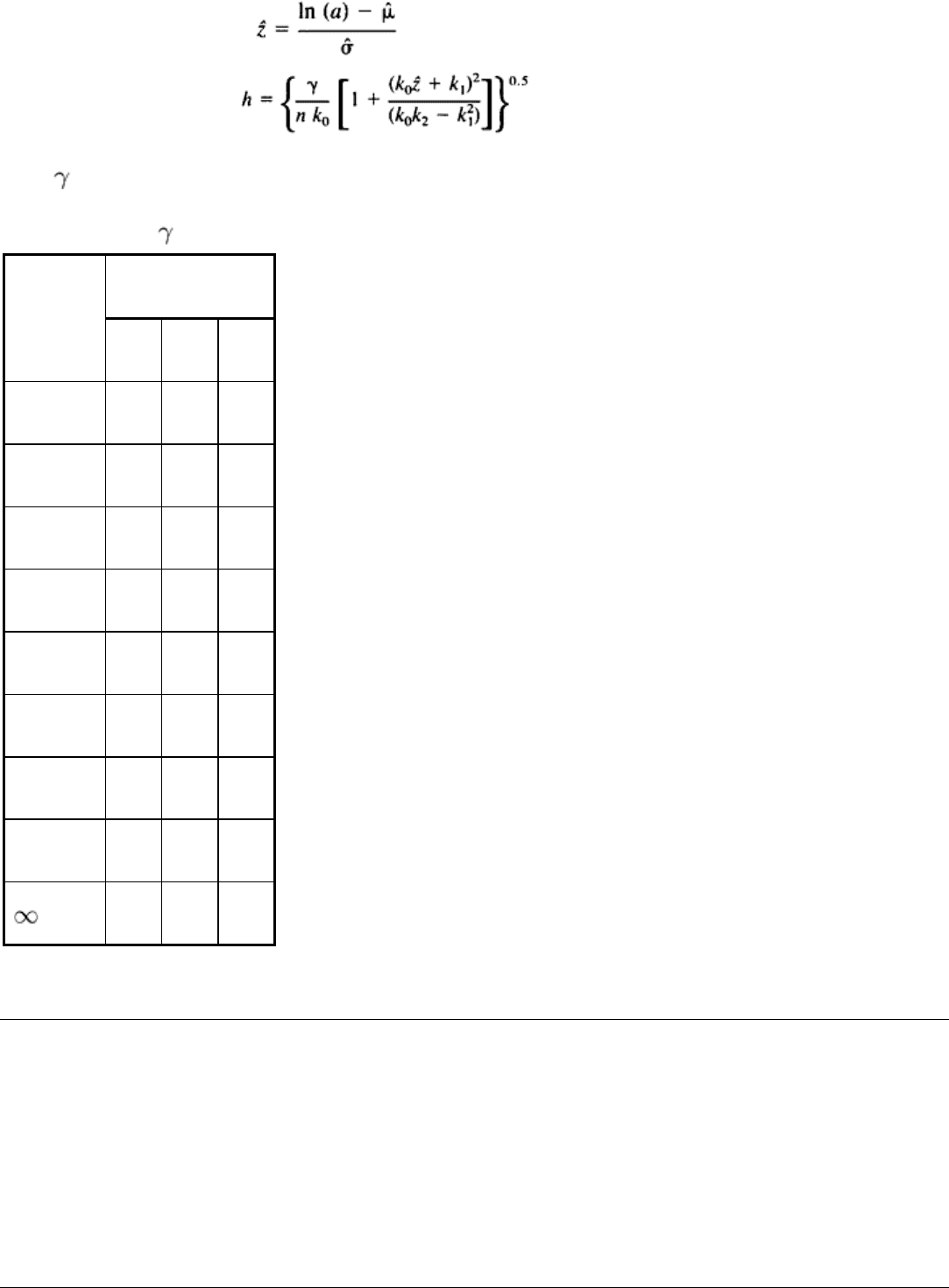
(Eq 24)
(Eq 25)
where is obtained from Table 3 for the number of cracks in the experiment and the desired confidence level.
Table 3 Values of for lower confidence bounds on the POD(a) function
Confidence level, %
Sample size
90 95
99
20 3.903
5.243
8.401
25 3.884
5.222
8.376
30 3.871
5.208
8.359
40 3.855
5.191
8.338
50 3.846
5.180
8.325
60 3.839
5.173
8.317
80 3.831
5.165
8.306
100 3.827
5.159
8.300
3.808
5.138
8.273
References cited in this section
10.
H. Cramer, Mathematical Methods of Statistics, Princeton University Press, 1946
11.
J.F. Lawless, Statistical Models and Methods for Lifetime Data, John Wiley & Sons, 1982
12.
R.C.H. Cheng and T.C. Iles, Confidence Bands for Cumulative Distribution Functions of Continuous
Random Variables, Technometrics, Vol 25 (No. 1), Feb 1983, p 77-86
13.
R.C.H. Che
ng and T.C. Iles, One Sided Confidence Bands for Cumulative Distribution Functions,
Technometrics, Vol 32 (No. 2), May 1988, p 155-159
NDE Reliability Data Analysis
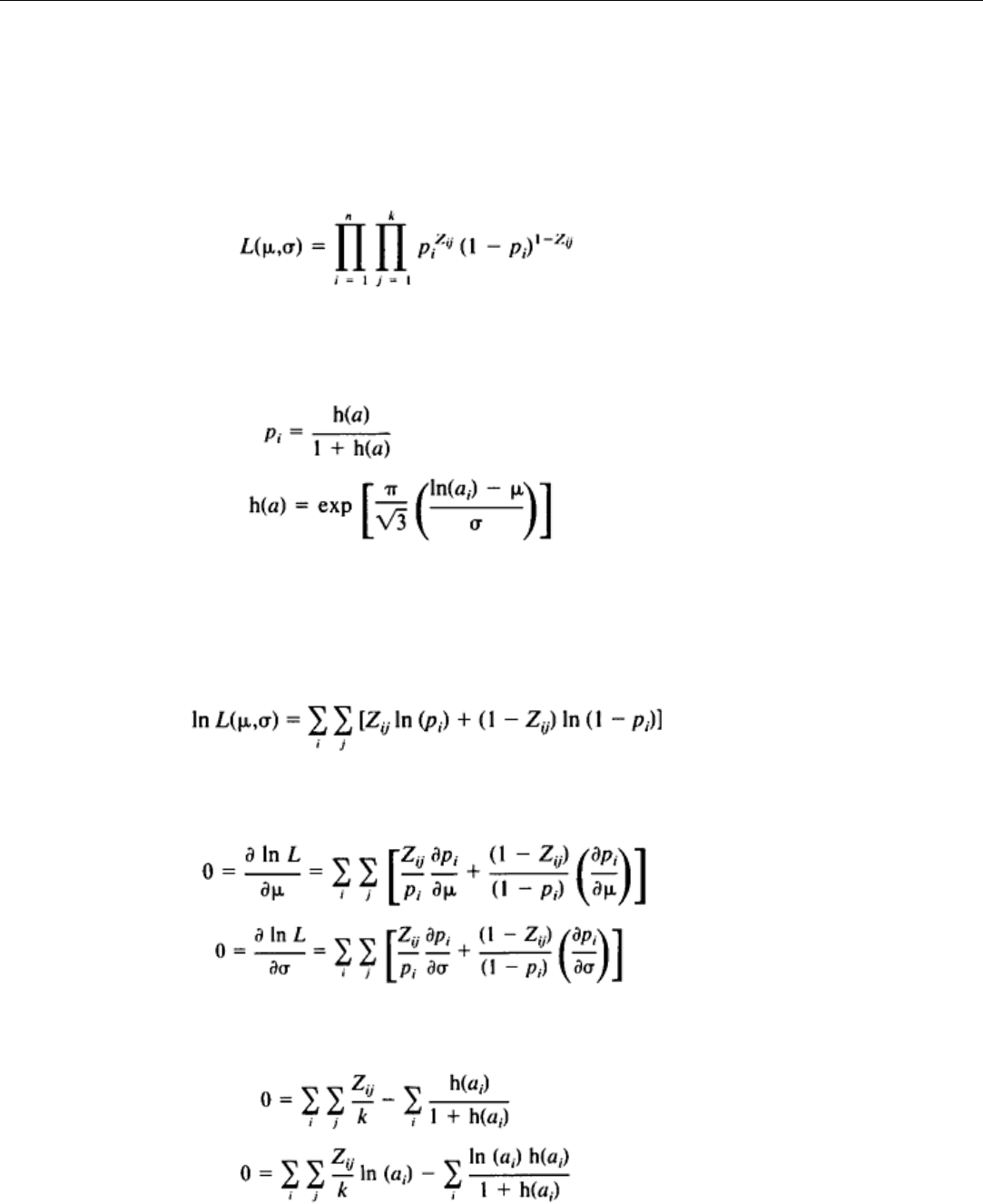
Alan P. Berens, University of Dayton Research Institute
Analysis of Hit/Miss Data
Estimation of the parameters of the log odds model for hit/miss data is based directly on the probability of each 0 or 1
result of an inspection. Assume that a balanced experiment has produced k inspections on each of n cracks. For this
application, the likelihood function is given by:
(Eq 26)
where Z
ij
= 0 or 1 for the jth inspection of the ith flaw producing a miss or a find, respectively, and the probability of
detecting a flaw of size a
i
is given by:
(Eq 27)
(Eq 28)
This form of the POD(a) function is simply a more convenient algebraic form of Eq 4. The vector of parameters to be
estimated is defined by θ= (μ,σ)'.
The log likelihood equation is:
(Eq 29)
Parameter Estimation in Hit/Miss Analysis. The maximum likelihood estimates are given by the solution to:
(Eq 30)
(Eq 31)
Taking the derivatives and simplifying yields:
(Eq 32)
(Eq 33)
Any standard computational method, such as the Newton-Rhapson iterative procedure (Ref 14), can be used to find the
solutions to Eq 32 and 33.

Because iterative techniques converge to local maxima, the solution to Eq 32 and 33 may be sensitive to the initial values.
A set of initial values based on the method of moments has been found to be useful (Ref 7). These are given by:
(Eq 34)
(Eq 35)
where X
1
,. . .,X
n
are the ordered values of the natural logs of the flaw sizes and p
i
is the observed percentage of detections
of the ith ordered flaw size. If convergence is not obtained, increasing the initial estimate of a has often provided
convergence. However, Eq 32 and 33 are not always solvable. This will be discussed further in the section "Comments on
Hit/Miss Analysis" in this article.
Confidence Bound Calculation in Hit/Miss Analysis. The information matrix is estimated from Eq 21, using
and for and . For this POD(a) model, the elements of the information matrix are given by:
(Eq 36)
(Eq 37)
(Eq 38)
Note that k
0
, k
1
, and k
2
, the parameters required in the calculation of the lower confidence bound on the POD(a) function,
are also defined by Eq 36, 37, and 38. All of the parameters required by Eq 23, 24, and 25 to calculate the lower
confidence bound on the POD(a) function are available.
Hit/Miss Analysis Examples. As examples of the application of the method to real data, the parameters of the log
odds POD(a) function were obtained for the data in Table 1. Table 4 presents a summary of the parameters of the POD(a)
function for each data set of Table 1 and the combination of the three data sets in a single analysis. Figure 7 shows the
POD(a) function and the lower 95% confidence bound for Inspector A and the same information when the data from the
three inspectors are combined. Adding inspections of the same cracks did not increase the precision of the estimate of the
POD(a) function. Figure 8 compares the POD(a) functions for the three inspectors and the composite.
Table 4 POD(a) parameters for the hit/miss data in Table 1
Inspector Parameter
A B C
Composite
0.96 1.11 0.82
0.96
0.59 1.04 0.87
0.88
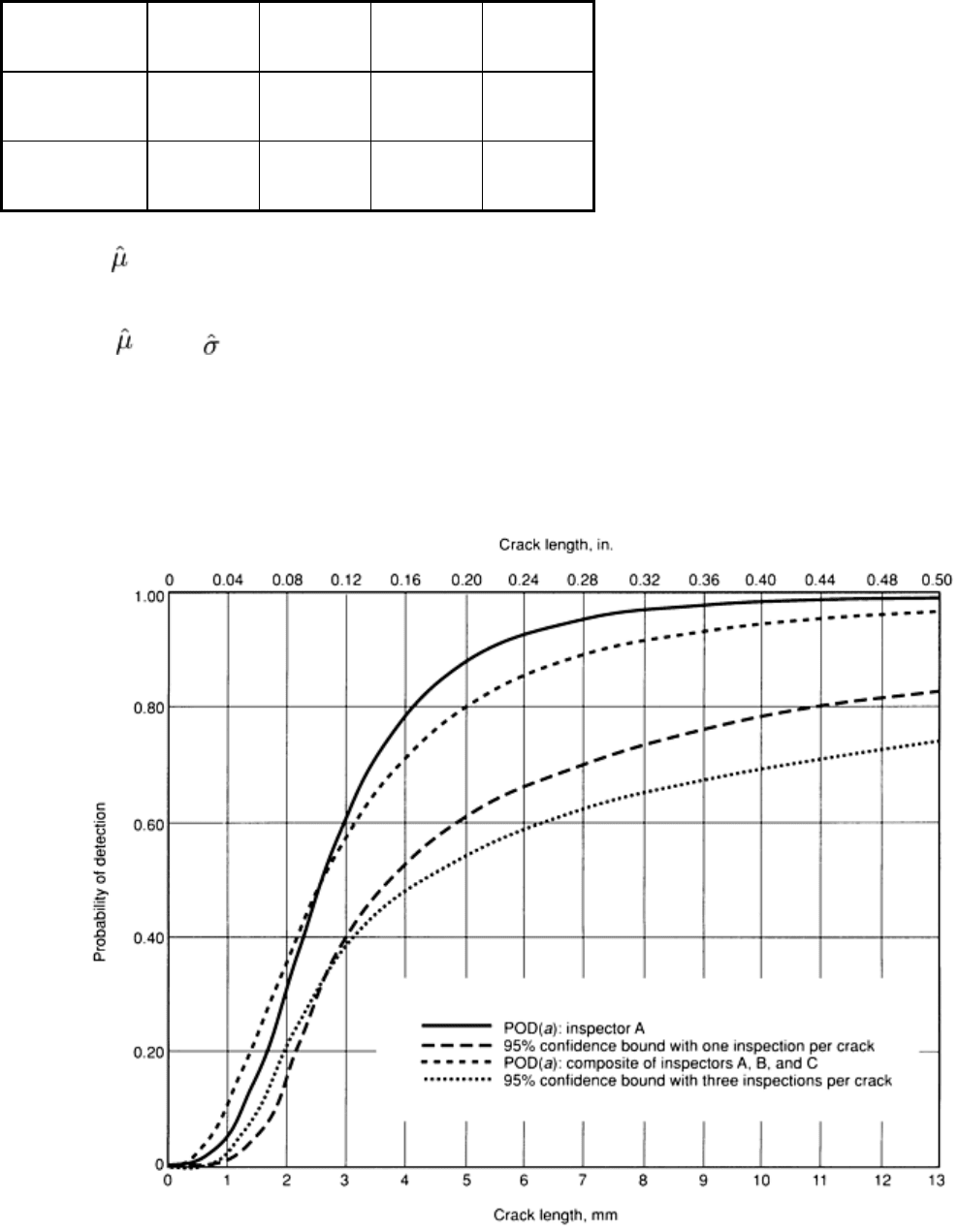
a
50
, mm (in.)
(a)
2.62 (0.103)
3.03 (0.119)
2.27 (0.089)
2.61 (0.103)
a
90
, mm (in.)
(b)
5.34 (0.210)
10.6 (0.417)
6.54 (0.257)
7.18 (0.283)
a
90/95
, mm (in.)
(c)
21.6 (0.850)
232 (9.13) 38.8 (1.53) 51.0 (2.01)
(a)
a
50
= exp( ) = estimate of crack size at 50% POD.
(b)
a
90
= exp( + 1.282 ) = estimate of crack size at
90% POD.
(c)
a
90/95
= upper 95% confidence bound on the estimate
of a
90
.
Fig. 7 POD(a) function and lower 95% confidence bound from hit/miss analysis of the data in Table 1
for one
insp
ection per crack (from Inspector A) and for three inspections per crack (from the composite result of
Inspectors A, B, and C)

Fig. 8 POD(a) functions from hit/miss analysis of the data in Table 1
Comments on Hit/Miss Analysis. In a well-designed experiment of sufficient sample size for which the log odds
model is a reasonable representation of the POD(a) function, the maximum likelihood hit/miss analysis will provide a
valid solution. Conversely, lacking any of these elements, it is possible that either no solution or an unacceptable solution
can result. If there is no overlap in the flaw size ranges of the detections and misses, Eq 32 and 33 will not yield a
solution. More flaws are needed in the region of increase of the POD(a) function. It is also possible to obtain an estimate
of a POD(a) function that decreases with flaw size if the inspection system is poorly designed or not in control and if
large flaws tend to be missed more often than small flaws. Both of these types of results are readily apparent, albeit
disconcerting.
A third type of unacceptable result is an apparently acceptable POD(a) function but a confidence bound that eventually
decreases with flaw size. This situation is most easily understood in terms of the log odds versus log flaw size plot. If the
slope is positive, the POD(a) function will appear reasonable, but if it is not significantly greater than zero, the lower
confidence bound will eventually decrease with flaw size. Therefore, a decreasing confidence bound is evidence of lack
of fit of the log odds model.
Finally, lack of fit of the model is often manifest in large values of coupled with small values of or extremely wide
confidence intervals. Although there are, in general, insufficient data in hit/miss experiments to test hypotheses about the
POD(a) model, as a minimum each fit should be subjectively judged. For example, in Fig. 9, the observed detection
proportions of each crack in the data of Table 1 are superimposed on the composite POD(a) function and confidence limit
from Fig. 7. The uncertainty in the POD(a) function as indicated by the width of the confidence bound seems justified by
the plot of the raw data. In this example, if greater precision (narrower confidence bounds) were desired, more cracks in
the 2 to 8 mm (0.08 to 0.3 in.) range would be needed in the experiment. Such plots provide an indication of the fit of the
model to the data as well as the range of flaw sizes that are contributing to the information from which the POD(a)
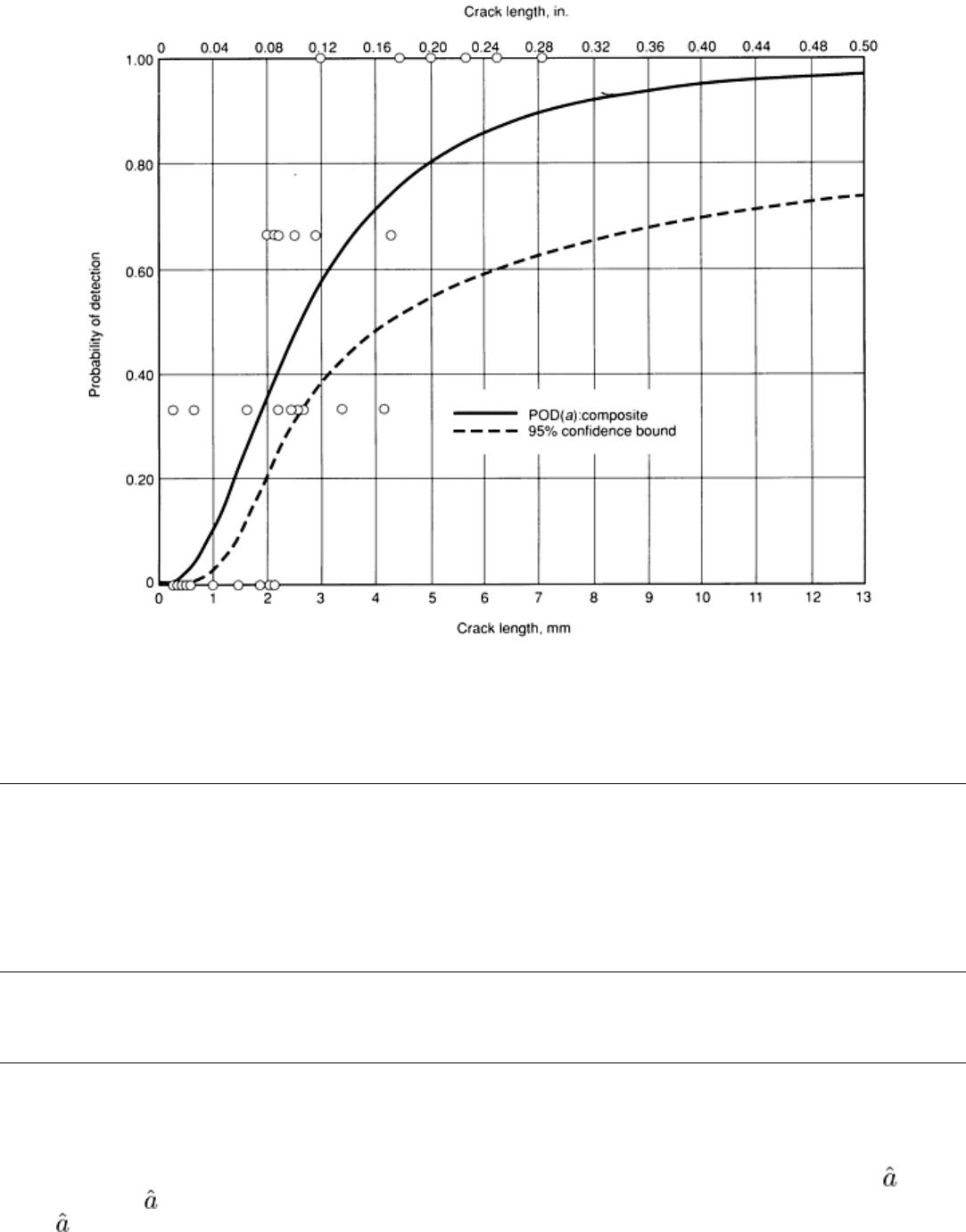
function is being estimated. This is true even for experiments in which there is only one inspection per crack and all
detection probabilities are plotted at 0 or 1.
Fig. 9 Example fit of hit/miss POD(a) function and lower 95% confidence bound
to observed detection
probabilities (three inspections per crack)
References cited in this section
7. A.P. Berens and P.W. Hovey, "Flaw Detection Reliability Criteria, Volume I--
Methods and Results,"
AFWAL-TR-84-4022, Air Force Wright-Aeronautical Laboratories, Wright-
Patterson Air Force Base, April
1984
14.
A. Ralston, A First Course in Numerical Analysis, McGraw-Hill, 1965
NDE Reliability Data Analysis
Alan P. Berens, University of Dayton Research Institute
Signal Response Analysis
In signal response data analysis, the parameters of the POD(a) function are calculated from parameters of the versus a
relation. If all the values are between the signal recording threshold and the saturation limit, a simple regression analysis
of ln ( ) versus ln (a) will yield the necessary information to estimate the POD(a) function and its lower confidence
